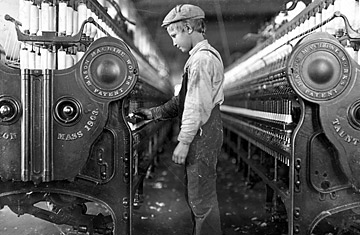
The government has not had a lot of ideas for what to do about the nation’s anemic job market, but there are troubling signs that one old idea is starting to re-emerge: child labor. In the first part of the 20th century, there was a concerted effort to end the scourge of children working in factories and textile mills. But now there is a small but noticeable drive to weaken these protections.
Maine grabbed headlines in late May when it enacted a law rolling back restrictions on the employment of minors. Children under the age of 18 can now work 24 hours a week — up from 20 — and as late as 10:15 on school nights, up from 10 p.m. (the bill’s backers wanted to raise the cutoff to 11 p.m.). The law diluted protections that had been put in place in 1991, when teachers were complaining about working students falling asleep in class.
(See pictures of the child tobacco farmers of Kazakhstan.)
Maine’s rollback was relatively modest. Its child-labor laws are still stricter than in many states, including some of its neighbors. But the legislature considered going further. Another bill would have allowed employers to pay workers under 20 a “training wage” of $5.25, instead of the standard Maine state minimum wage of $7.50. It would also have eliminated the limit on how many hours a minor over 16 can work on a school night.
Earlier this year, Missouri considered a more Dickensian proposal. A bill there would have removed state restrictions on employing children under the age of 14, along with limits on how many hours children could work per day. It would also have ended routine state inspections of companies employing children.
The sponsor, state senator Jane Cunningham, insisted that she was just trying to “put back some common sense” in the law, and that, “We’re not doing students any favor by telling them, ‘You cannot work.'” Of the proposed Missouri bill, Jay Leno quipped on The Tonight Show, “Well, yeah, why should the 10-year-olds in China be getting all the good factory jobs?”
Of course, even if states eliminated their anti-child-labor laws, there would still be federal restrictions. The Fair Labor Standards Act, the capstone of FDR’s New Deal, puts limits on the use of child labor — though in many cases they are weaker than state laws; for example, many states put limits on the number of hours and how late 16- and 17-year-olds can work, which federal law does not. (The federal law also has exceptions for agricultural work, in which child labor remains all too common.)
(See “School Is a Right, but Will Indian Girls Be Able to Go?”)
The Fair Labor Standards Act, however, is itself coming under attack. Mike Lee, a U.S. Senator from Utah, elected last year with Tea Party support, has publicly questioned the constitutionality of federal anti-child-labor laws. Other Tea Party leaders — including Joe Miller, the losing GOP Senate candidate in Alaska last year — have made similar arguments. In doing so, they ignore Supreme Court precedent going back to 1941, holding that Congress has the right to restrict child labor.
The case for anti-child-labor laws is not complicated: it is based on the belief that children’s primary focus should be education, so they can reach their full potential, not paid drudgery. Critics of child labor in the U.S. have been making this case since 1836, when Massachusetts became the first state to regulate the employment of children.
Much of the current pressure for loosening the restrictions is coming from businesses that employ young people, especially the fast-food industry. They want more freedom to schedule high school students on long shifts and late at night. And they would like to pay minors less than the minimum wage.
When they argue for the changes, they talk about the great advantages that looser rules would have for young people — giving them “greater flexibility” in their work lives and valuable work experience. Of course, it is not clear how valuable the experience of handing burgers out of a drive-through window after 10 p.m. on a school night actually is.
(See “The Education Crisis No One Is Talking About.”)
Not surprisingly, research shows that working interferes with children’s ability to get an education. Studies have found that the more students work, the lower their grades. Working more than 20 hours a week has been tied to academic and behavioral problems, and to increased dropout rates. Minors, who do not have to pay rent or support a family, can afford to work for less — and will, if the state creates a lower-tier minimum wage for them. In many cases they are also more malleable workers, less eager to challenge working conditions or join unions.
World Day Against Child Labor, which was created to call attention to abusive child-labor practices around the globe, will be observed on June 12. The focus is, as it should be, on abusive practices in places like Bangladesh and Haiti. But Americans should use the occasion to think about where child-labor laws are headed at home — and plan for what appears to be a concerted campaign to turn back the clock.
More Must-Reads from TIME
- Cybersecurity Experts Are Sounding the Alarm on DOGE
- Meet the 2025 Women of the Year
- The Harsh Truth About Disability Inclusion
- Why Do More Young Adults Have Cancer?
- Colman Domingo Leads With Radical Love
- How to Get Better at Doing Things Alone
- Michelle Zauner Stares Down the Darkness
Contact us at letters@time.com